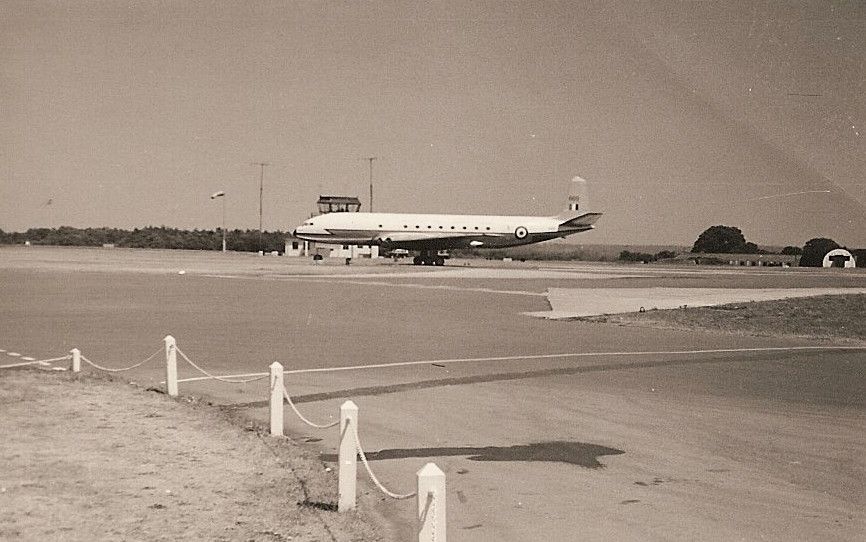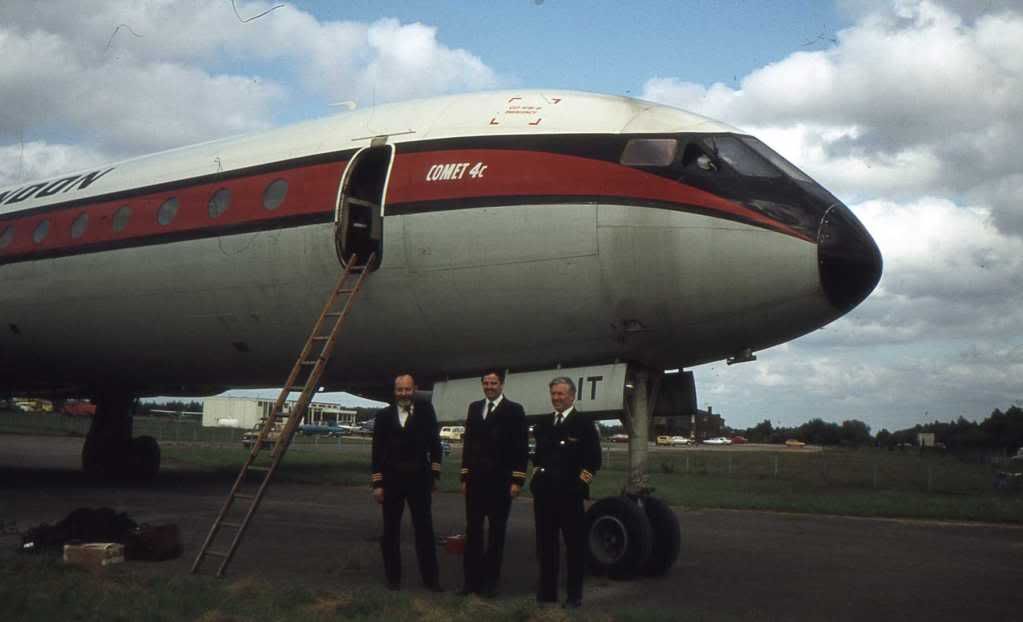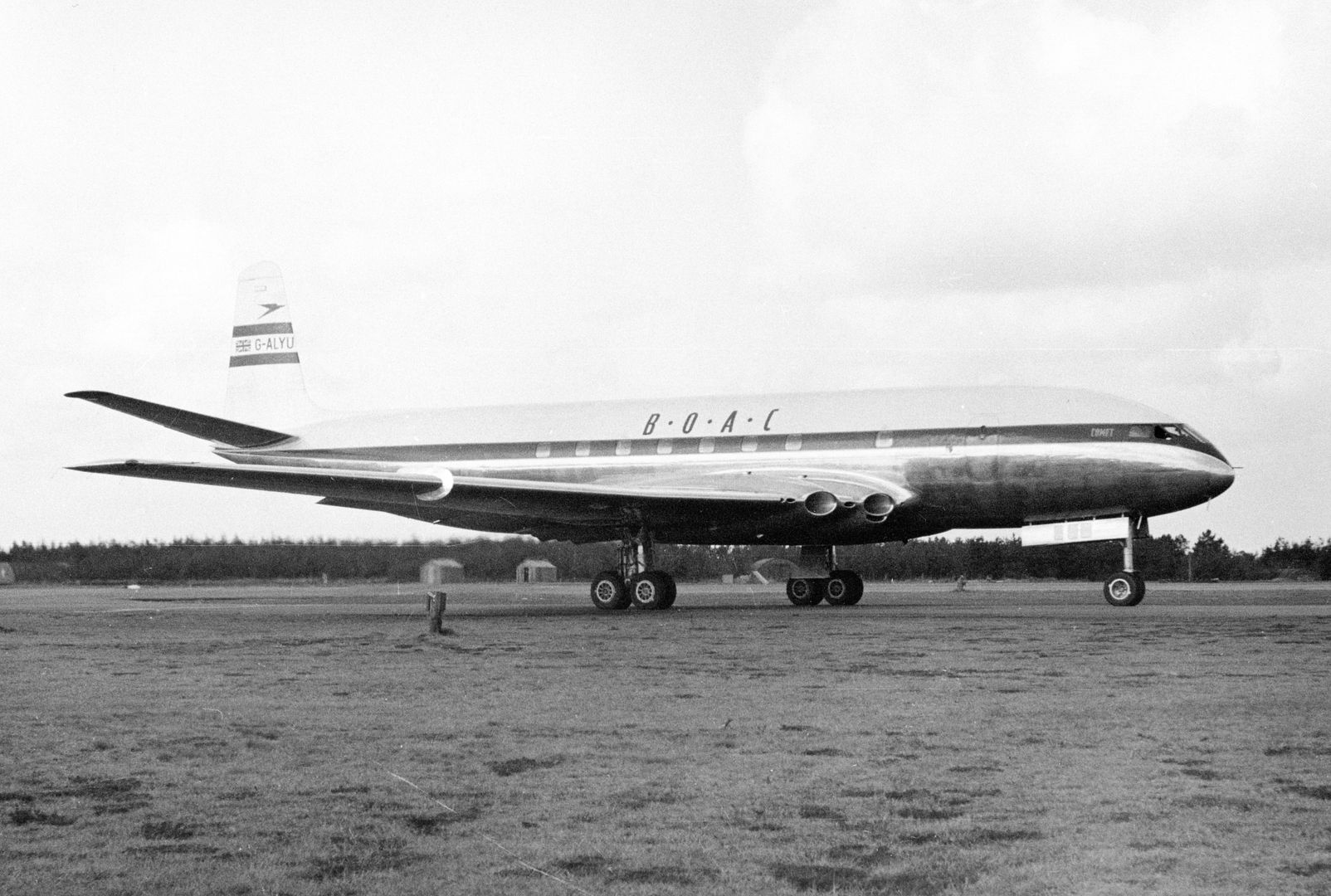Post by flyboy on Sept 13, 2016 20:03:58 GMT
THE DH 106 COMET.
The Comet 1.
In 1943 the Brabazon Committee, a Government appointed body, proposed that an airliner capable of flying across the Atlantic at 400mph/640km/h should be designed. A Committee member, Sir Geoffrey de Havilland used his personal influence to champion its development. This was accepted by British Overseas Airways Corporation (BOAC) for their use and in 1947 production was started on an initial order for eight aircraft to be registered G-ALYS - G-ALYZ. The latter aircraft was delivered to BOAC in September 1952.
The design had to be capable of much higher and faster flight than any previous airliner and was therefore to have a highly pressurised cabin and would be powered by 4 de Havilland Ghost turbo jets housed within the wings. On 27 July 1949 the prototype, with Class B registration G-5-1, first flew with test pilot John Cunningham at the controls. By now registered G-ALVG it was displayed to the public for the first time at the Farnborough Air Show in 1949. There followed flight trials and the second prototype G-5-2 / G-ALZK joined the BOAC Comet Unit at Hurn from April 1951 for 500 hours of crew training and route proving.
However, the aircraft was judged to be under powered by the Ghost engines and BOAC only accepted the aircraft on the understanding that these engines would be replaced with more suitable and powerful Rolls-Royce Avon engines once development of them was complete. In order to lessen the aircraft weight very light-weight gauge aluminium was used for the fuselage construction and metal bonding replaced many of the usual rivets.
The cost of a new Comet 1 in 1952 was £275,000.
In due course the light weight aluminium contributed greatly to the metal fatigue and breakup of the aircraft in the air. No-one of course knew of the pending problems when the worlds first jet passenger service was started in May 1952 by BOAC between London Heathrow and Johannesburg in South Africa.
After three crashes in the first year and a further two aircraft which broke up in mid air in 1954 the types airworthiness certificate was revoked and the Comets grounded.
The accident investigation was to become the most extensive ever undertaken world-wide. At RAE Farnborough aircraft remains were rebuilt as far as possible and a complete fuselage was repeatedly pressurised in a specially constructed massive water-tank to simulate a huge number of flights. On one of these tests a rupture in the fuselage leading from a window panel was to lead to the discovery that metal fatigue was the cause of the mid-air breakups.
The cause of the accidents having been found and published both Boeing and Douglas were quick to take advantage of the findings and incorporate them in their Boeing 707 and Douglas DC-8 aircraft. The Comet was thus placed at a great disadvantage but development work was already underway incorporating many redesigns from the test findings. This was to lead to a series of different models which proved successful but with limited production runs.
VARIANTS
The Comet 1
Two prototypes produced with single large wheeled undercarriage and square windows.
Twelve aircraft were produced with square windows and four wheeled bogie main undercarriage units replacing the single wheels of the prototypes. Forty plus passengers could be carried.
The Comet 1A.
In 1953 ten upgraded aircraft known as the Comet 1A were produced with six being ordered by French airlines, Air France (3) and Union Aeromaritime de Transport (3). With two being destined for the Royal Canadian Air Force. These aircraft, all had increased fuel capacity and higher weight allowances.
The Comet 1X
Two Royal Canadian Air Force Comet 1A aircraft were rebuilt with heavier gauge skin and uprated to a Comet 2 fuselage standard.
The Comet 1XB
Four Comet 1A were upgraded to 1XB standard with reinforced fuselage and oval windows.
N.B Both 1X series aircraft were limited in the number of pressurised cycles they were allowed to make.
The DH 111 ( PR Comet).
Designed to meet Air Ministry specification B35/46 for a nuclear bomber, in fact this de Havilland design had originally been known as the 'PR Comet' to be used for high altitude photography. Modified to meet B35/46 the design was turned down by the Royal Aircraft Establishment where serious concerns were raised regarding weapons storage. With the development of the V bomber force proceeding de Havilland abandoned the project in 1948.
The Comet 2.
Was a development which had a longer fuselage and more powerful Rolls-Royce Avon engines and slightly longer wings. They also had heavier gauge skin and rounded windows following the Comet 1 disasters. Orders were placed by five overseas airlines, Japan Airlines, Air India, British Commonwealth Pacific Airlines, Panair do Brazil and Linea Aeropostal Venezolana (all of which were cancelled) in addition to the 12 forty-four seat aircraft ordered by BOAC for the south Atlantic routes. The first production aircraft, G-AMXA first flew on 27August 1953. All but 4 production Comet 2 were modified to overcome the fatigue problems with most serving as RAF C.2 with deliveries starting in 1955. Roles performed by the aircraft for the RAF varied between passenger carrying, freight, VIP transport and carrying of medical equipment including iron lungs. Some aircraft, designated 2R were even modified to be used for specialised ELINT and electronic surveillance roles.
Comet 2X
A single Comet 1 aircraft was fitted with 4 Rolls-Royce Avon 502 engines and was used for development of the Comet 2.
Comet 2E
Two Comet 2s were fitted with Avon 504 engines in the inner nacelles and Avon 524s in the outer ones. Used by BOAC in 1957-1958 on proving flights.
Comet T2
On the 9 December 1955 the first of two crew trainer variants flew for the RAF. The first aircraft XK669 was taken from an order for 10 RAF Comet 2s for the RAF.
Comet C.2
216 Squadron RAF received eight Comet 2s designated C.2. They had originally been destined for the civil market.
Comet 2R ELINT
Three Comet 2s were modified for radar and electronic system development. The 2R series was also equipped to monitor Warsaw Pact signals traffic and was operated until in 1974 the role was handed over to the Nimrod R1 .
* It should be noted that many of the earlier Comets, due to previous airworthiness problems and cancellations of many orders were discarded or modified as in the case of the RAF Comet C.2. Many of the discarded aircraft were stored at Hatfield.
The Comet 3.
Planned for supply to American airlines including Capital Airlines, National Airlines and Pan Am, who all placed orders. This was to be an even longer range version with a larger cabin for trans atlantic operations, however, all orders were cancelled in favour of the Comet 4 and only two prototypes were constructed. The one Comet 3 to fly was G-ANLO which appeared at the 1954 Farnborough Air Show. The other was not completed to production standards and was used mainly as a ground based structural test airframe being of a similar size to the under development Comet 4. Nine additional Comet 3 airframes were not completed and were abandoned at Hatfield. Following a world tour captained by John Cunningham in December 1955 the aircraft was much modified with shorter wings and Avon RA29 engines.
The Comet 3B
G-ANLO became the Comet 3B after the modifications were completed as shown above and was demonstrated in British European Airways colours at the September 1958 Farnborough Air Show.
In 1961 it was in use by the Blind Landing Experimental Unit at RAE Bedford before use in automatic landing and later foam arrester trials. In 1973 it went to BAE Woodford for use as the mock-up for the Nimrod project.
The Comet 4.
Launched by BOAC in 1958 the aircraft was longer in length and had external wing tanks added to give longer range. In addition to many other improvements it was powered by four powerful Rolls-Royce Avon engines. BOAC were soon operating a fleet of these aircraft and started the first trans Atlantic service between New York and London on 4 October 1958 with seats for 48 passengers. Later aircraft could be offered with 74 to 81 revenue seating configuration. The Comet 4 was also operated by Aerolineas Argentinas and East African Airways. In the later 4C it was possible to seat 119 passengers in a charter seating package. The Boeing 707 was to be introduced on the trans Atlantic service only a few weeks later. In November 1965 BOAC retired it's Comet 4 fleet from revenue service. Dan Air played a significant role in the fleets' continued use.
The Comet 4A
Originally developed for Capital Airlines.
The Comet 4B.
Was designed specifically for BEA to use on shorter routes with seating for up to 99 passengers. BEA ordered 16 aircraft and started services with them by the end of 1959. An additional 2 aircraft were supplied to Olympic Airways bringing the total produced to 18 in the series.
The Comet 4C.
This was a combination of the earlier Comet 4 wing and the 4B fuselage giving higher capacity plus the longer range. This model was mainly supplied to the RAF and overseas customers, examples being Kuwait Airways, Middle East Airlines, Misrair, Mexicana and Sudan Airways. It was the most popular Comet variant with 23 being produced. The last two 4C fuselages ( XV147 & XV148 ) were used to build prototypes of the Hawker Siddeley Nimrod maritime patrol aircraft.
One of the 4C aircraft ( registered SA-R-7 ), was ordered by Saudi Arabian Airlines but was later used exclusively on the Saudi Royal Flight where it was used by King Saud Bin Abdul Aziz. With a smart green, gold and white colour scheme and highly polished wings and lower fusilage it was fitted with a VIP front cabin, a bed and special toilets with gold fittings. Following completion at the factory and after it's first flight it was known as 'the worlds first executive jet'. This aircraft was destroyed in an accident 20.3.63 on Monte Matto, Italy.
There was a Comet 5 proposal but it never got past the initial design phase, the RAF Nimrod was to follow being a development of the Comet 4 fuselage.
Many Comets of various variants were purchased by independent operators once released from service by the original airline operators and the RAF, in this capacity they remained in service for a number of years.
In the mid 1970's the only remaining commercial operator was Dan Air who eventually purchased over the years a total of 49 Comet aircraft, although most were used to supply spares for their flyable fleet. At any one time during Dan Air's use there were a maximum of 18 in service and the final revenue flight was made in 1982.
In military service the RAF were by far the largest operator with Comets serving with 51 Squadron ( C.2 & 2R 1958-1975),
192 Squadron ( C.2 & 2R 1957-1958), 216 Squadron ( C.2 & C.4 1956-1975). The Royal Canadian Air Force 412 Squadron operated two Comet 1A (which were later modified to become the 1XB ) from 1953 to 1963.
Having been acquired by the Ministry of Technology, Comet 4C XS235 'Canopus', had been used for many years for trials work and is credited with making the last recorded production Comet flight. It is now kept in ground-running condition at Bruntingthorpe Aerodrome where fast-taxi runs are conducted.
Production Details.
The total number of Comet production was 114 aircraft, or 136 when including refitting and conversions. 76 were of the Comet 4 variants.
SPECIFICATIONS
Comet 1 Comet 4
Crew 4 + 36-44 pax 4 + 56-81 pax
Length 93' (28.35m) 111' 6" (33.99m)
Max Take Off Weight 110000lb (50000kg) 156000lb (71000kg)
Operating Range Appx. 1500mi (2400km) 3225 mi (5190km)
Cruise Speed 460mph (740k/hr) 520mph(840k/hr)
Wing Span 115' (35.05m) 115' (35.05m )
Engines 4X DH Ghost 50 4X Rolls-Royce Avon 524
COMETS VISITING BLACKBUSHE
Information on visiting aircraft shown below indicates registration, construction number, operator, date of visit and reason for the visit if known. Where training was the reason I have also tried to indicate the type of training and indicated if a landing was made. I feel sure that there were more than the number of movements shown but the following are all that are recorded.
I have used the following symbols: app. = approach, tr = indicates a training flight, ? xo/s = the number of overshoots, ldg = landing, n/s = night stop, del = delivery.
Comet 1
Registration. c/n. Operator Movements
G-ALYP 6003 BOAC 14.9.53 tr 3xo/s.
G-ALYR 6004 --//-- 19.5.52 tr, 16.3.53 tr 1xo/s, 18.3.53 tr 1xo/s,
25.3.53 tr 1x o/s.
G-ALYS 6005 --//-- 1.5.52 tr 2xo/s + 4xldg, 12.5.52 2xldg,
26.7.52 tr, 11.2.53 tr 1xo/s, 26.3.53 tr 1xo/s,
4.9.53 tr 1xo/s.
G-ALYU 6007 --//-- ?.9.50 tr, 22.9.52 tr, 20.3.53 tr 1xo/s,
26.5.53 tr 1xo/s, 28.8.53 tr 1xo/s.
G-ALYV 6008 --//-- ?.08.52 tr.
G-ALYW 6009 --//-- ?.08.52 tr, 10.2.53 tr 1xo/s, 20.6.53 tr 1xo/s,
25.9.53 tr, 30.9.53 tr 4xo/s.
G-ALYX 6010 --//-- 18.9.53 tr.
G-ALYY 6011 --//-- ?.?.54 tr.
G-ANAV 6013 --//-- 1.9.53 tr 1xo/s, 14.10.53 tr, 28.1.54 tr,
1.2.54 tr, 3.2.54 tr, 6.2.54 tr, 10.2.54 tr,
13.2.54 tr, 20.2.54 tr, 22.3.54 tr, 27.3.54 tr.
Comet 1XB
5301 6017 Royal Canadian Air Force 29.4.53 tr, 1 approach from Hurn.
Comet 2.
G-AMXD 6026 --//-- 12.2.58 tr.
G-AMXK 6033 --//-- 4.11.57 tr, 16.2.58 1xldg ( Emergency landing due
engine failure ).
Comet C.2
XK669 6024 Royal Air Force 20.6.59 ldg 216sqn from Gibraltar.
XK695 6030 --//-- 28.3.59 ldg.

XK698 6034 --//-- 18.7.58 ldg.
XK699 6035 --//-- 15.4.59 ldg.
Comet 4
G-APDA 6401 BOAC 21.3.59 tr, 22.3.59 tr + n/s.
G-APDB 6402 --//-- 19.9.58 BOAC first del. Comet 4, 23.9.58 tr,
1.11.58 tr.
G-APDF 6409 ? --//-- 25.1.59 tr.


G-BDIT 6467 Dan Air / D.Arnold Withdrawn from Dan Air service 1980
Arrived Blackbushe June 81
(Flown In) - Broken up 1984.
Part of the proposed D.Arnold Museum
Previously XR395 C.4 RAF del. 29.8.74.
Credits:
Wikipedia
DM Flight Sim
rj information, book on Blackbushe out shortly.
The enthusiasts who made their log books available.
pb for the photo's. JSM 17.9.16.

